Raúl Pagès Wins the Inaugural Louis Vuitton Prize for Independent Creatives with his RP1 Régulateur à Détente: Here’s Why
Congratulations to Raúl Pagès for winning the 2024 Louis Vuitton Prize for Independent Creatives with his RP1 Régulateur à Détente. The prize comes with a substantial grant of 150,000 euros and a 12-month mentorship with La Fabrique du Temps Louis Vuitton.
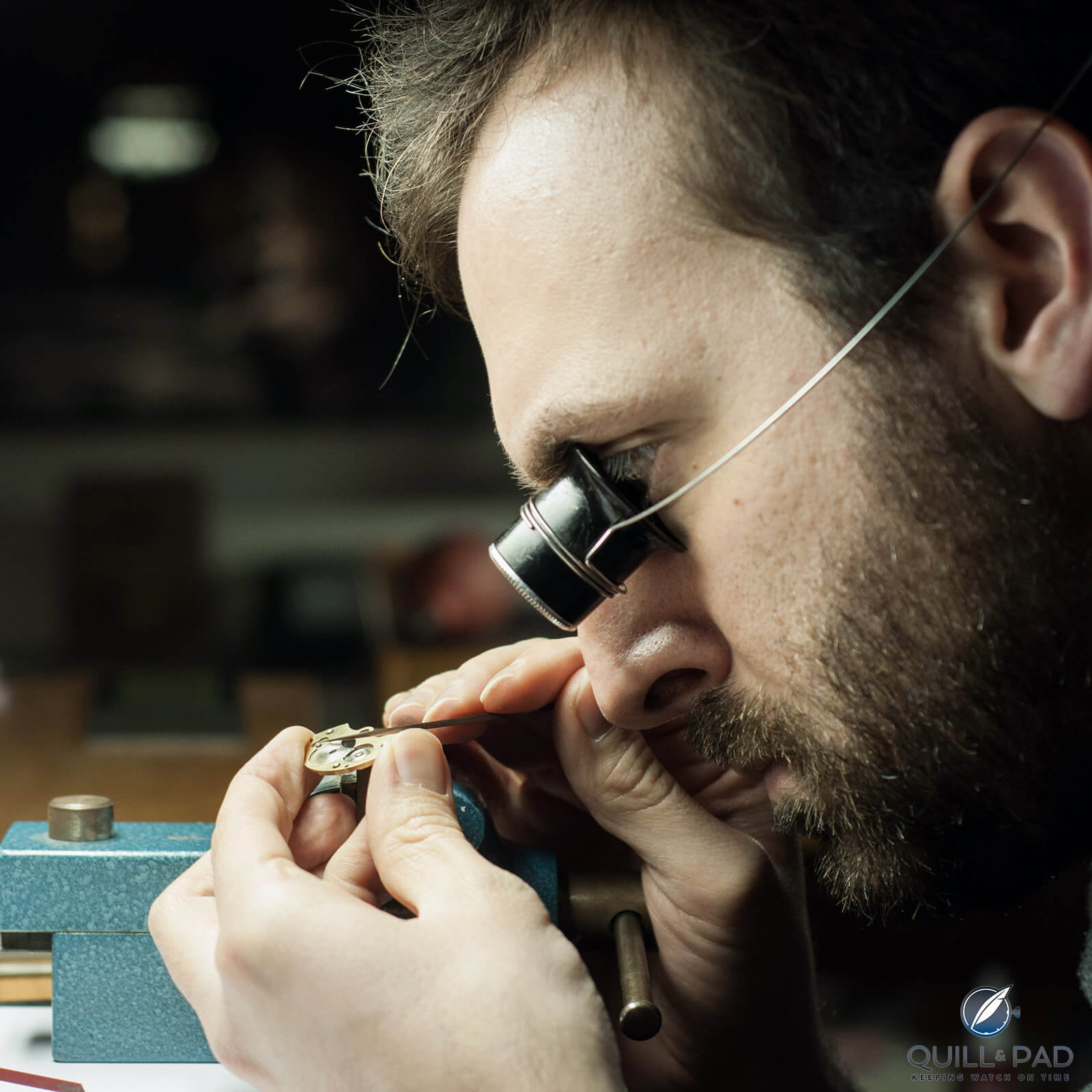
Raul Pagès
Raúl Pagès is an independent Swiss watchmaker (movement designer and restorer). In 2005, he obtained his diploma of watchmaker-restorer in antique watchmaking with honors, then in 2006 his diploma of designer in watch complications at the CIFOM in Le Locle. Pagès is an accomplished musician, and a lover of art history and 20th-century design history.
In 2012, he set up his own business to manufacture the 352 components of his Tortue automaton entirely by hand. Building on this experience, in 2016 he designed and manufactured his first timepiece, Soberly Onyx, in a limited edition of 10 pieces.
In 2022, Pagès launched his RP1 Régulateur à Détente, one of the very rare wristwatches with a detent escapement.
In 2017, he became a member of the Académie Horlogère des Créateurs Indépendants (AHCI).
Raul Pagès Régulateur à Détente RP1: Innovating Tradition
The evolutionary tree is filled with branches where life diverged and took different paths to fill various ecological niches. This is a simple way to understand the phylogenetic lineage of common ancestors and the shared traits that evolved before the species split from each other. One can trace the development of unique traits that are only found in limited groups of animals and traits that are found in nearly all living creatures.
Tracing also helps us to understand how some creatures branched off early on and have no closely related relative, staying almost exactly the same for millions or billions of years (or having all relatives go extinct).
Since life began almost 3.5 billion years ago, a majority of life in that time has been single-cell organisms. Only a billion years ago did multicellular life evolve, and since then the variety of living things has exploded.
But the tree of life has a bunch of evolutionary loners, species that are the only member of their branch, a great example being Homo sapiens, aka humans. The genus homo appeared just over two million years ago when it diverged from other members of the taxonomic family Hominidae (which today includes orangutans, gorillas, chimpanzees, bonobos, and humans).
There were a variety of homo species including Homo erectus, Homo habilis, and Homo neanderthalensis, many of which existed at the same time.
Eventually, all the other species went extinct and Homo sapiens were the only ones left on our lonely branch of evolution. If it weren’t for the success of Homo sapiens one could wonder if a single-species branch is a sign of an evolutionary dead end, but that clearly is not the case.
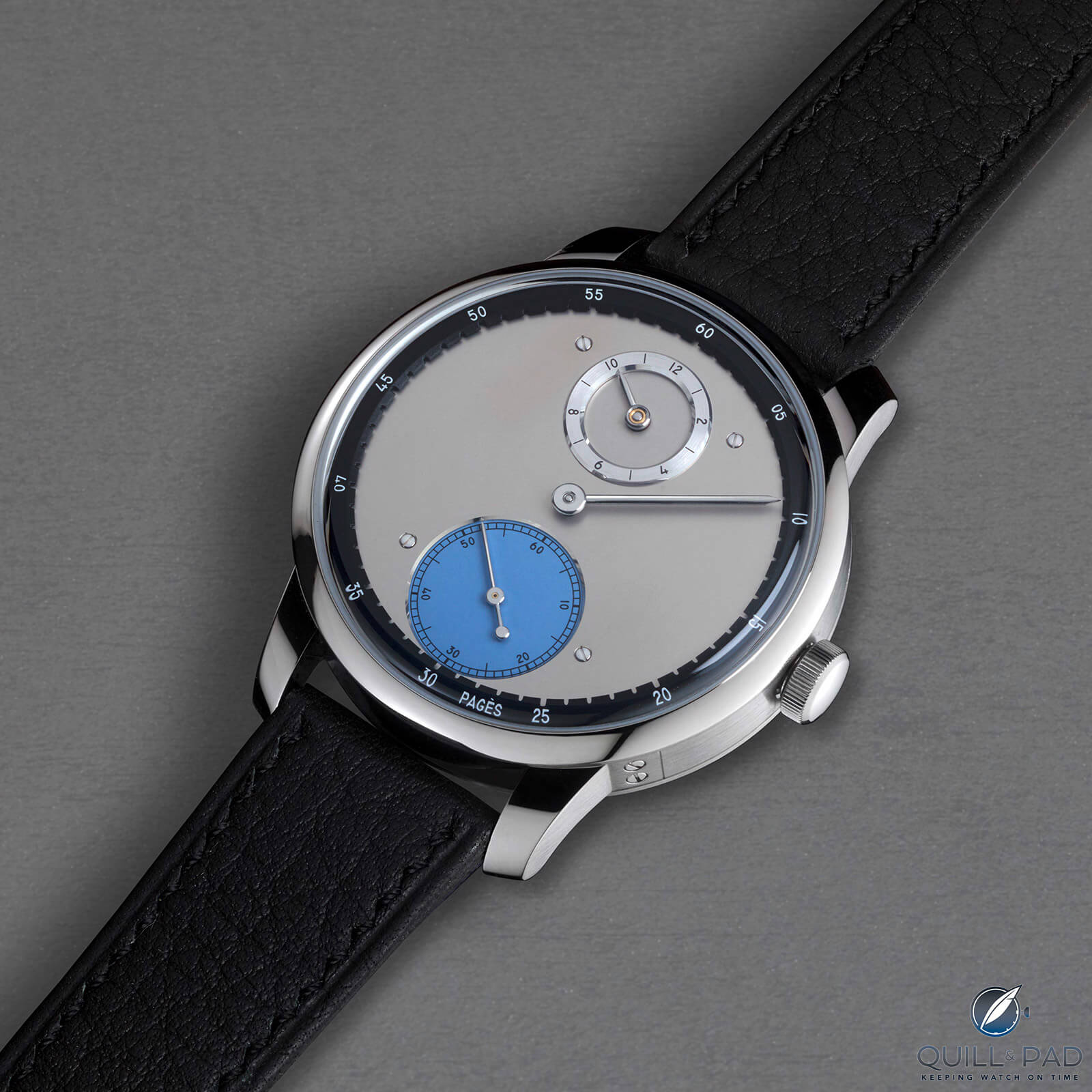
Raul Pagès Régulateur à Détente
The same can be said for horological inventions that have no close relatives such as the detent escapement. It sort of stands alone on its own mechanical evolutionary branch and has risked extinction, but it is still alive and well thanks in part to independent watchmaker Raúl Pagès who just released his new Régulateur à Détente RP1.
A clean and minimal design, the Régulateur à Détente RP1 introduces Pagès’ take on the detent escapement and shows that evolution is still possible.
——————————————————————————————————-
—————————————————————————————————–
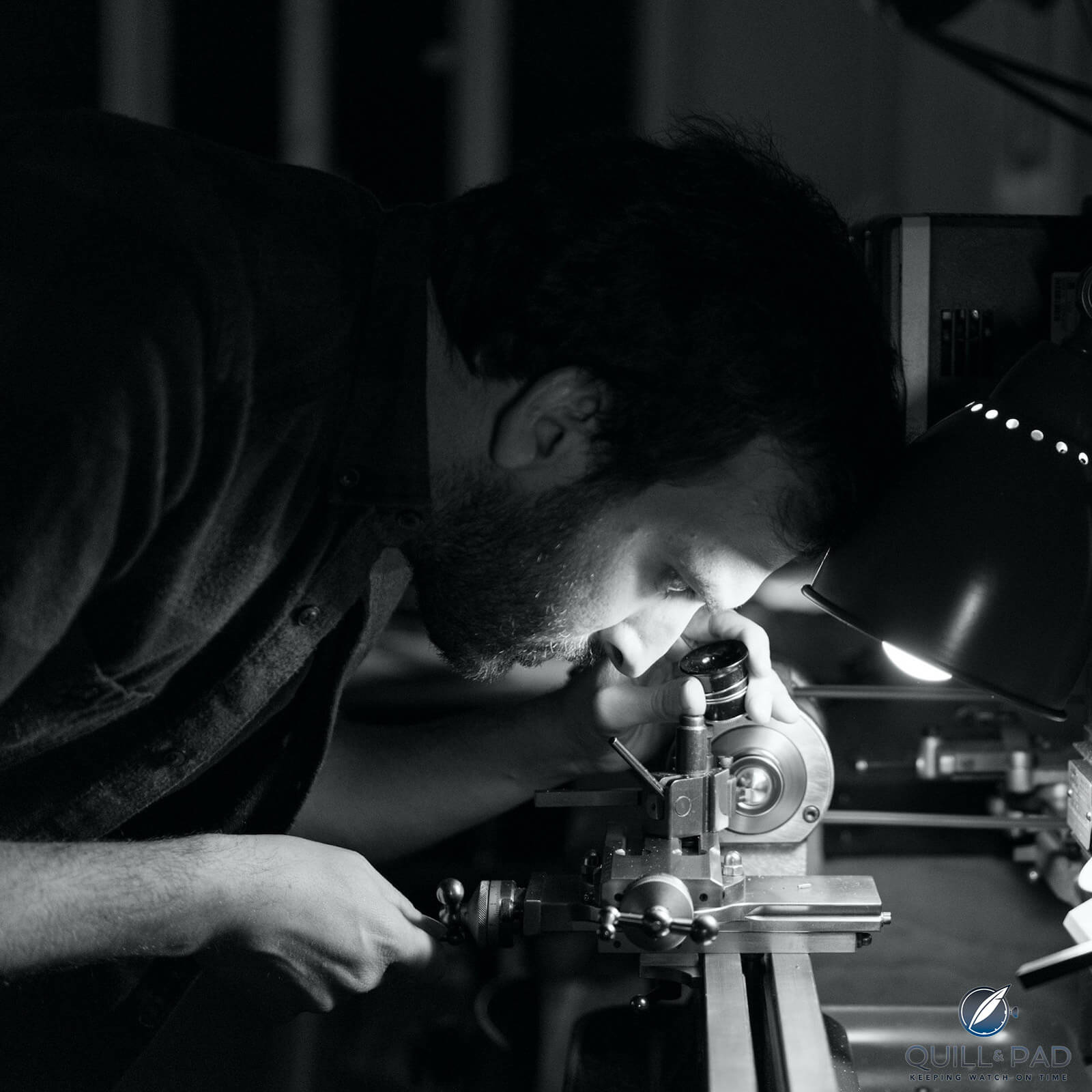
Raul Pagès
Raul Pagès Régulateur à Détente RP1
The Régulateur à Détente RP1 is a deceivingly simple-looking regulator watch with central minutes, offset hours at 12 o’clock, and seconds 6 o’clock. The dial design is very clean but still has a handmade appearance thanks to four dial screws, printed numerals on all indexes, and a chapter ring for minutes that mimics an internal ring gear with small slots for each minute.
The design is inspired by Swiss architect and designer Le Corbusier, whose influence is visible.
The chapter ring for minutes cantilevers the flange from the dial in a similar way to architectural designs from Le Corbusier, giving the dial visual depth that wouldn’t be possible without adding thickness.
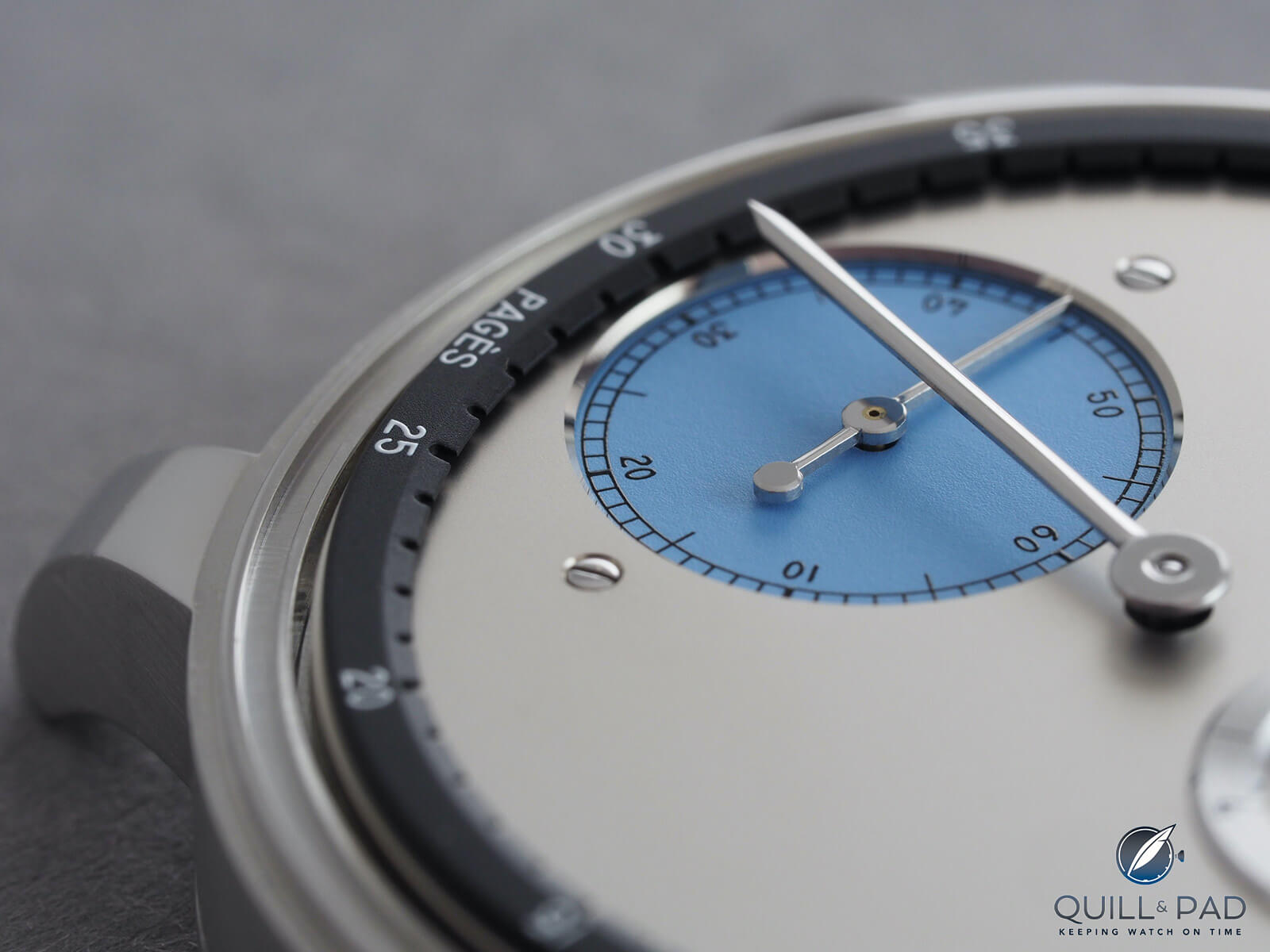
Raul Pagès Régulateur à Détente dial detail
The seconds subdial adds lightness with its vivid color, a cerulean blue taken from Le Corbusier’s Polychromie Architecturale of 1959. Le Corbusier intended it to represent the sea and sky and used it to visually uplift structures. It definitely pops on the dial of the Régulateur à Détente RP1.
—————————————————————————————————–
—————————————————————————————————–
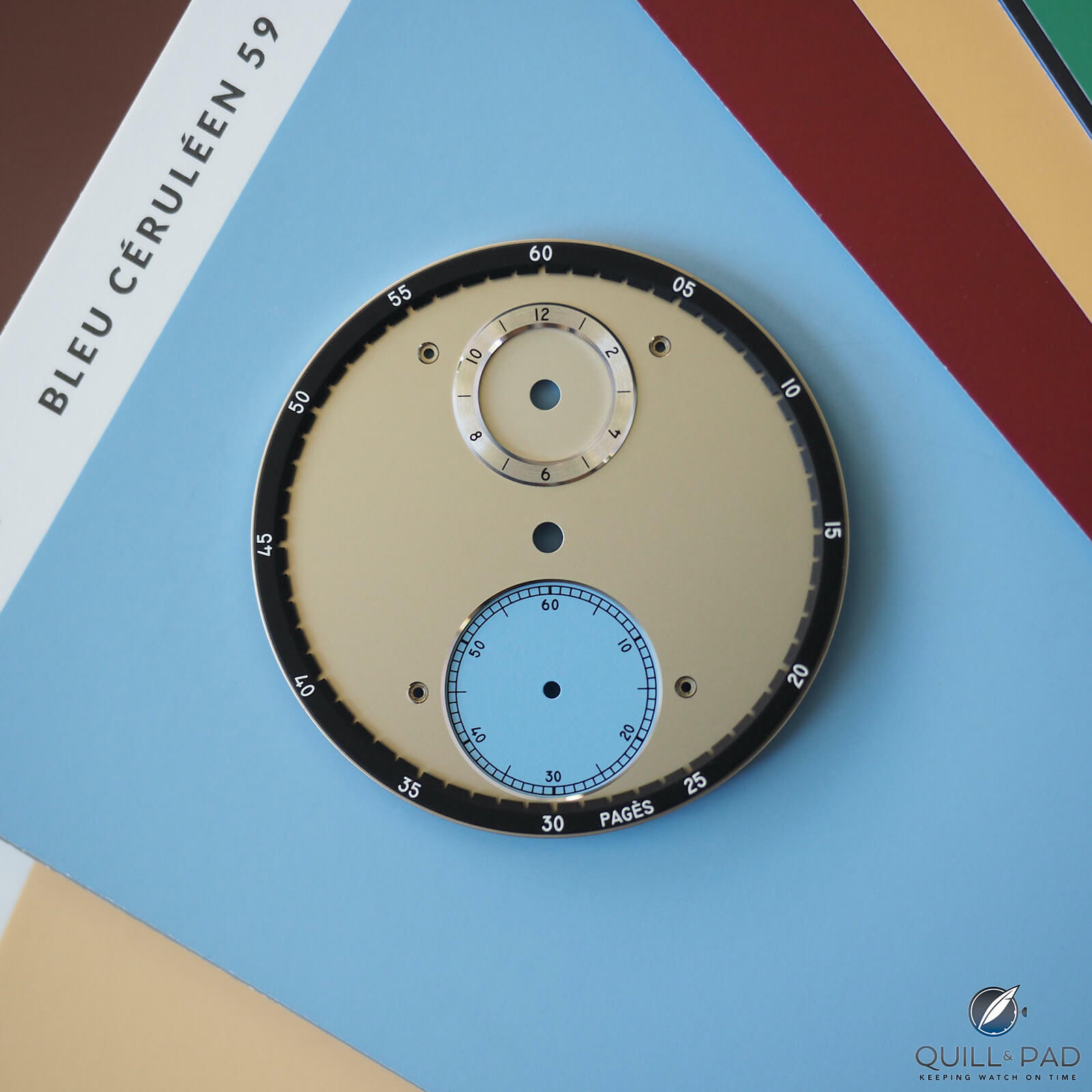
Raul Pagès Régulateur à Détente dial
Combined with the black of the chapter ring and the medium grey of the main dial – a callback to the masonry of Le Corbusier’s architecture – this watch has one foot firmly planted in the mid-century modern aesthetic and another in the very contemporary minimalist design. Yet the design is only there to gain a passing glance; it’s the movement that captures a fan’s deep appreciation for the watchmaker.
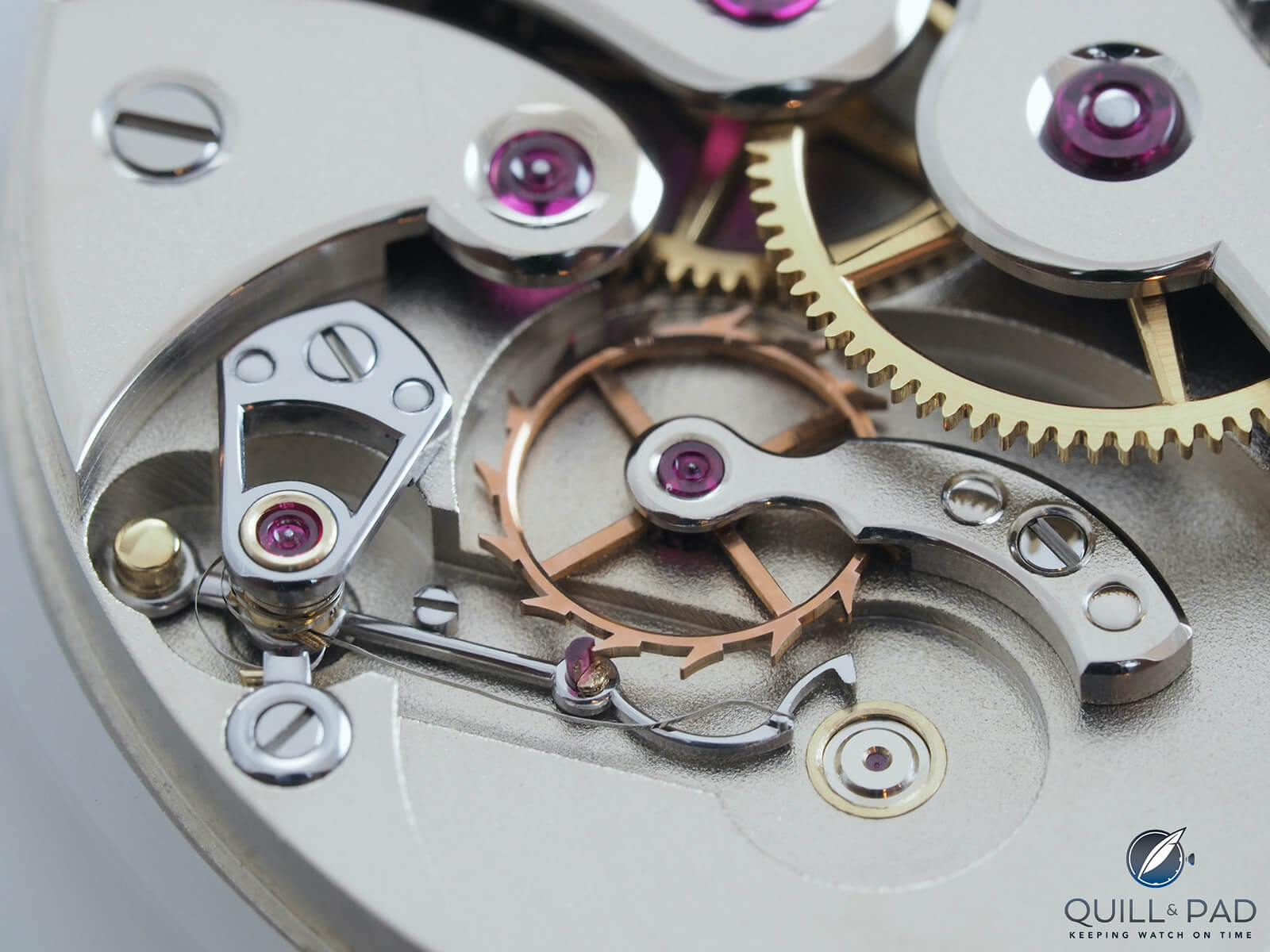
Raul Pagès Régulateur à Détente escapement
The Régulateur à Détente RP1 movement is entirely handmade in-house by Raúl Pagès and features his take on the horological masterpiece that is the detent escapement. The highlight of the rear of the watch is this escapement, beating away at 3 Hz and seeming to function like magic thanks to a hidden fourth (seconds) wheel placed on the dial side of the main plate.
There is no visible connection between the balance and escapement and the rest of the going train, which kind of breaks your brain for a minute.
With the precise and very quick release of the detent escapement, the escape wheel doesn’t seem to rotate unless you watch the spokes of the wheel and you see no fourth wheel slowly and consistently rotating. This combines to highlight the function of the mechanism as a performance, which is exactly what you want when you design and construct a detent escapement.
Since it’s such a rare yet capable escapement, the purpose of using it must go hand in hand with the desire to show it off.
—————————————————————————————————–
—————————————————————————————————–
The detent escapement
Pagès is not a flashy designer who wants to show off in a brash way; he takes the path of subtle showmanship. That is the reason the fourth wheel is hidden and not covering or distracting from the escapement: it is meant to keep the focus solely on the mechanism and make you feel like it is a bit magical.
From a mechanics standpoint, the detent escapement is already an impressive and subtle engineering feat, and it takes a keen eye to even see how it functions.
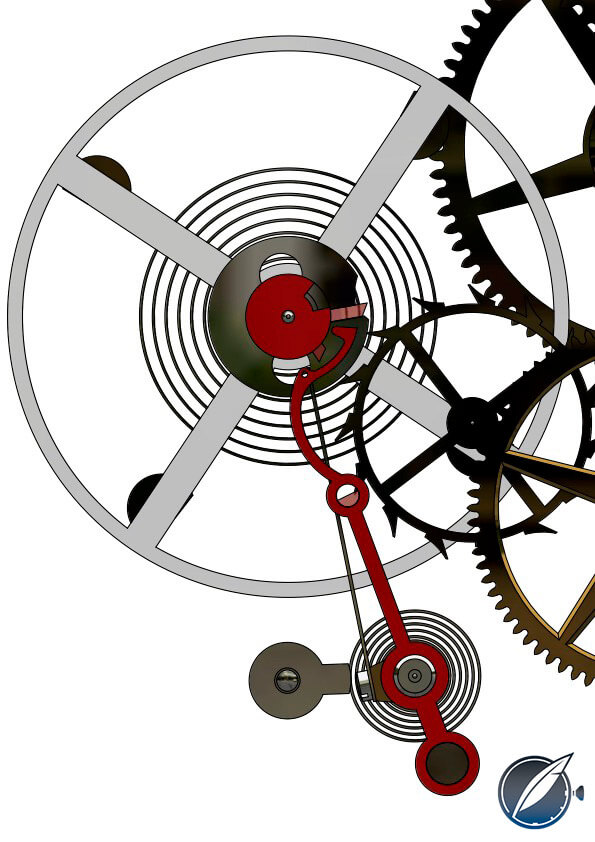
Raul Pagès Régulateur à Détente escapement diagram
It’s best to talk through the actual mechanism to highlight why it is so much more precise and better for chronometry than the Swiss lever escapement, and this execution is a solid example for this.
The detent escapement was first developed in 1748 by Pierre Leroy to increase precision and isochronism. The main feature of the detent escapement is the direct impulse of the escape wheel on the balance, which eliminates friction and energy loss while providing a very consistent force to the balance.
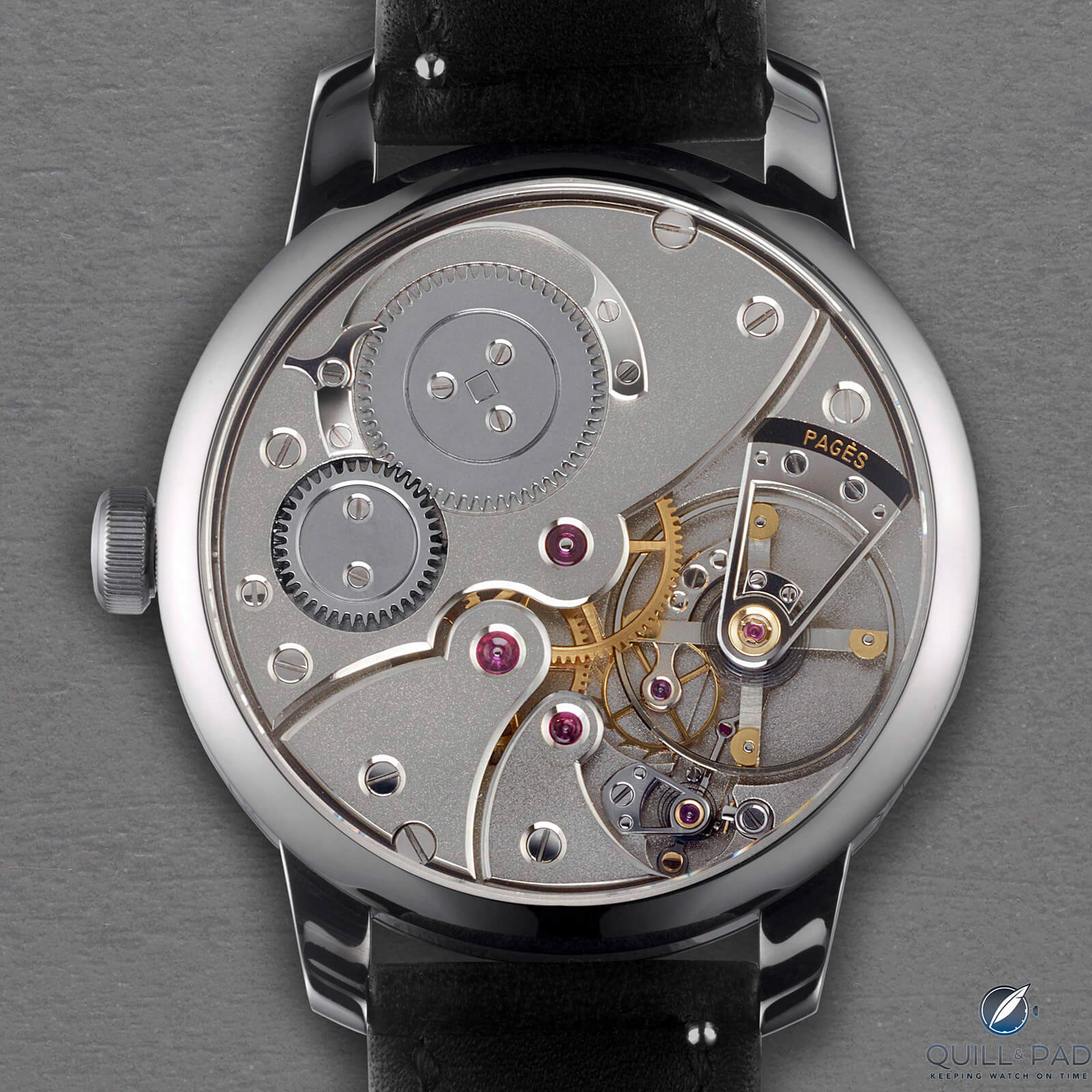
Raul Pagès Régulateur à Détente movement
The escape wheel is held in place by a very delicate spring with a jewel attached to it. The balance wheel unlocks this mechanism directly, allowing it to advance one position and provide a push to the escape wheel.
The design is very precise and consistent, but historically notorious for being sensitive to shocks, which is why it found limited use in wristwatches and earlier pocket watches that weren’t marine chronometers.
In Pagès’ escapement, the detent lever extends up to the balance wheel staff and uses a sort of reverse shepherd’s hook preventing the detent from moving far enough to advance the escape wheel if bumped or shocked. It only allows the proper range of motion during the short window when the balance wheel is in the right location. This ensures no accidental release of the escape wheel at the wrong moment, which could stop the mechanism.
—————————————————————————————————–
—————————————————————————————————–
The skill and patience with which a mechanism like this must be fabricated and adjusted is nothing to shake one’s head at; very few watchmakers have taken on the challenge yet alone succeeded quite as well as the Régulateur à Détente RP1.
Thanks to Pagès’ extensive experience with pocket watch restoration and the creation of automatons, the detent escapement falls right in the sweet spot of his skills.
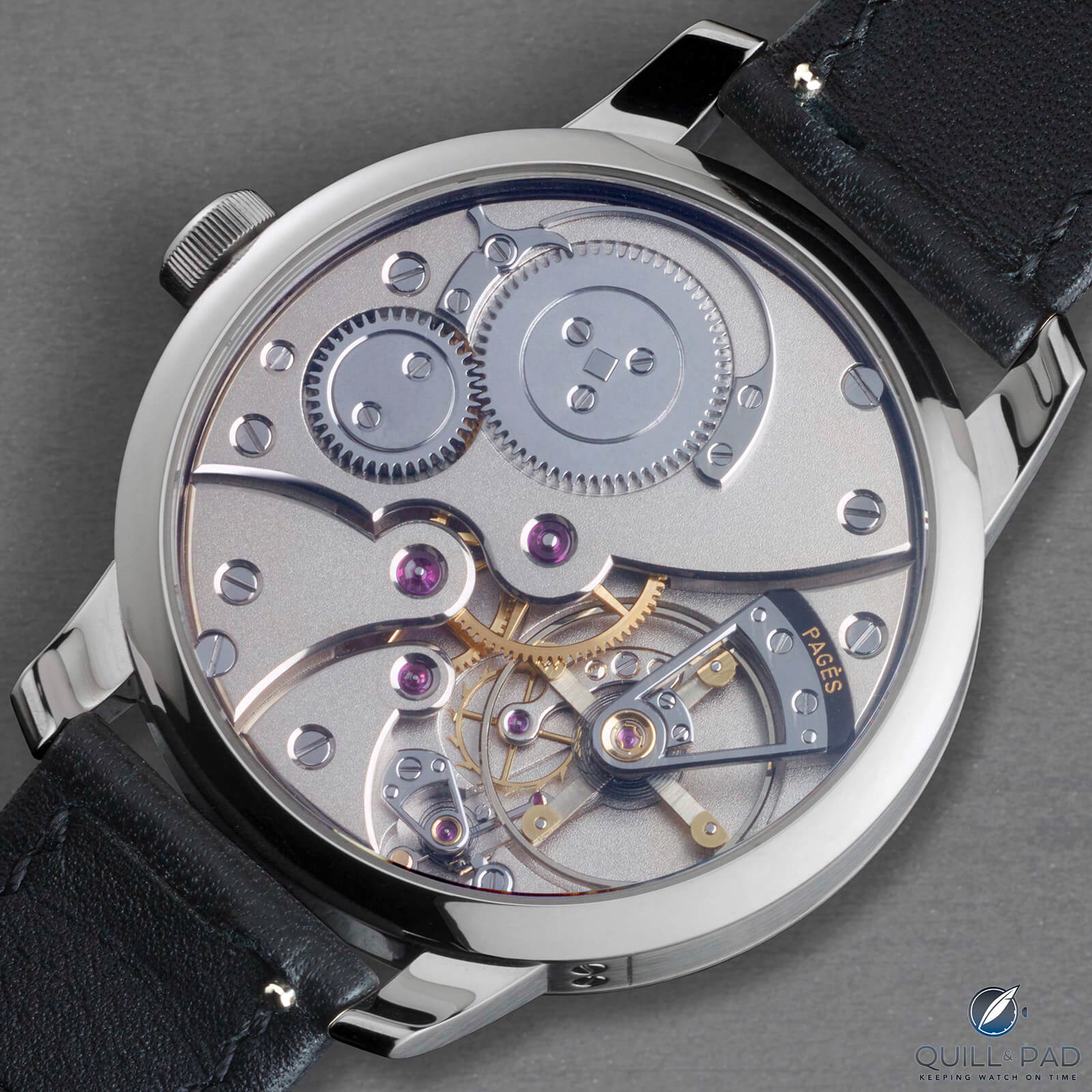
Raul Pagès Régulateur à Détente movement
And thanks to that experience, Pagès is able to finish the Régulateur à Détente RP1 to very high standards that border on masterful. He may have his work cut out to catch up to Philippe Dufour levels of finishing, but the style and hand skills are clearly headed in that direction.
If this watch had a traditional Swiss lever escapement and everything else was equal, I would still say this is a stupendous watch that would be perfect as a daily wearer. It has a beautiful and simple dial, a gripping layout, and excellent in-house movement execution. When you add in the technical complexity of the updated detent escapement, the watch becomes a bargain for what you are getting.
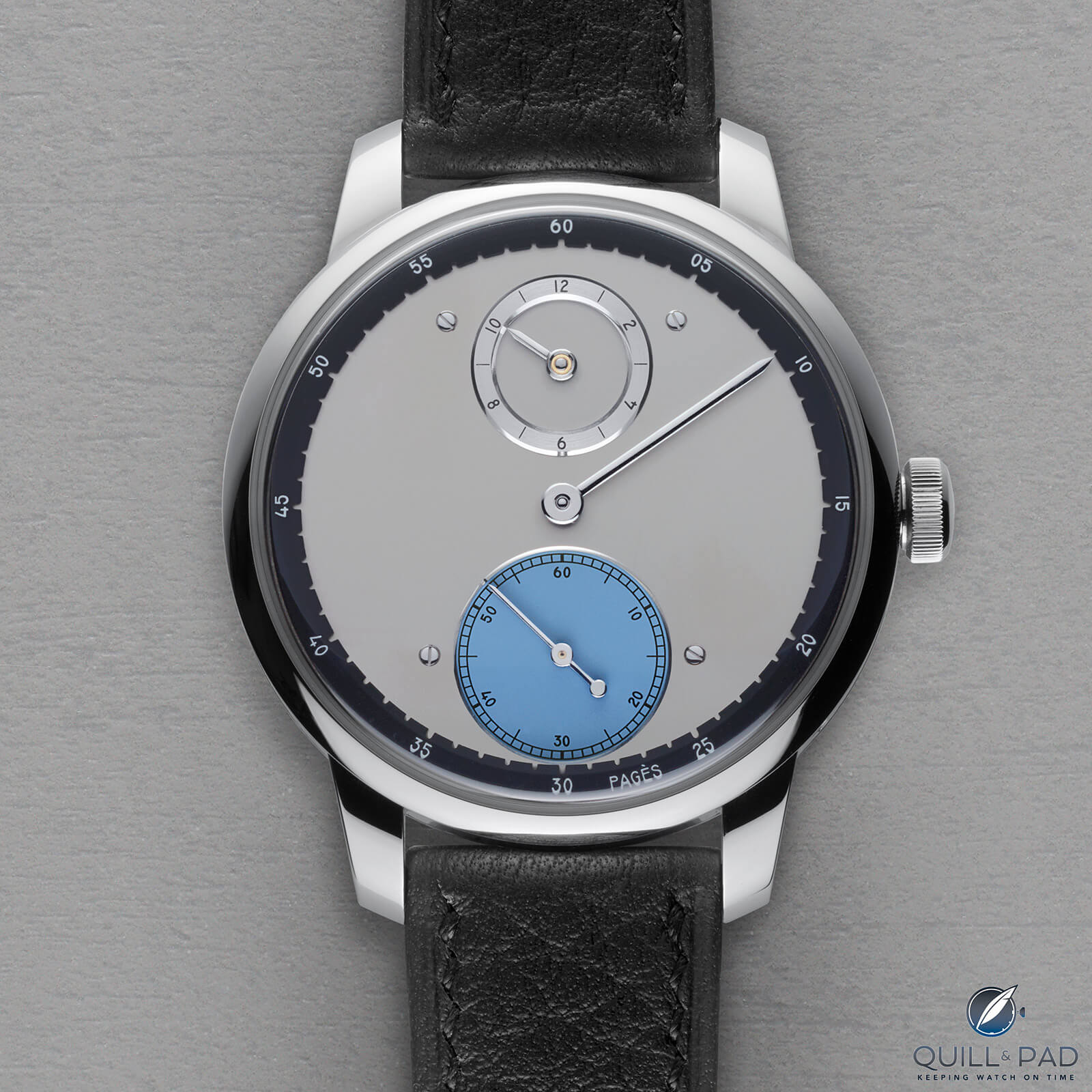
Raul Pagès Régulateur à Détente
His successful detent escapement also shows that innovation with a rather narrow use still has the ability to evolve and branch off from its predecessors to create something new. All it takes is an intrepid watchmaker seeking to do something few others have done. Sometimes, that is what makes all the difference between survival and disappearing into history.
I’m excited to see what else may be revived by Pagès, and until then I look forward to getting my hands on the Régulateur à Détente RP1 to experience it firsthand. While I wait, I’ll try my best to break this one down!
- Wowza Factor * 9.1 The sublimely clean dial combined with the simple, yet technical movement is a one-two punch of wow factor!
- Late Night Lust Appeal * 91» 892.405m/s2 This is the definition of a lustworthy watch for any wearer: it has the style, the technical chops, and the proportions to be an instant winner!
- M.G.R. * 68.8 A new independent detent escapement made by hand? I’ll take that every day!
- Added-Functionitis * N/A Like we’ve seen time and again, some of the best watches are time only, and this one is a great example. So no worries if you skip the Gotta-HAVE-That cream and just enjoy the chronometry!
- Ouch Outline * 10.1 Stubbing your toe on a 15-pound dumbbell! It is almost a guarantee that if you have your shoes and socks off and you are casually walking around your home eventually one of your toes will be magically attracted to something sharp or heavy. The pain can be drastic, but I’d still gladly accept that fate if it meant getting the Régulateur à Détente RP1 on my wrist!
- Mermaid Moment * It’s hidden behind that dial! The magic is hidden underneath the dial but when you find it there is no going back!
- Awesome Total * 772.8 Start with the color code of that stunning cerulean blue on the dial (59), multiply by the thickness of the case (10.2), and finally add the number of components in the RP1 movement (171) to discover a different level of awesome total!
For more information, please visit pageswatches.com/regulateur-a-detente.
Quick Facts Raul Pagès Régulateur à Détente RP1
Case: 38.5 x 10.2 mm, stainless steel
Movement: manually wound in-house Caliber RP1, 47-hour power reserve, 18,000 vph/2.5 Hz frequency with pivoted detent escapement and anti-tripping system, variable inertia balance
Functions: hours, minutes, seconds
Price: CHF 85,000
* This article was first published 20 February 2022 at Raul Pagès Régulateur à Détente RP1: Innovating Tradition
You may also enjoy:
Raúl Pagès Soberly Onyx: Unexpected Bests
John-Mikaël Flaux: Time That Moves & Magical Machines



Leave a Reply
Want to join the discussion?Feel free to contribute!